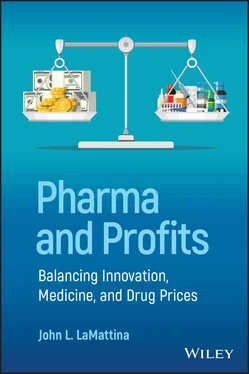John L. LaMattina - Pharma and Profits
Здесь есть возможность читать онлайн «John L. LaMattina - Pharma and Profits» — ознакомительный отрывок электронной книги совершенно бесплатно, а после прочтения отрывка купить полную версию. В некоторых случаях можно слушать аудио, скачать через торрент в формате fb2 и присутствует краткое содержание. Жанр: unrecognised, на английском языке. Описание произведения, (предисловие) а так же отзывы посетителей доступны на портале библиотеки ЛибКат.
- Название:Pharma and Profits
- Автор:
- Жанр:
- Год:неизвестен
- ISBN:нет данных
- Рейтинг книги:4 / 5. Голосов: 1
-
Избранное:Добавить в избранное
- Отзывы:
-
Ваша оценка:
- 80
- 1
- 2
- 3
- 4
- 5
Pharma and Profits: краткое содержание, описание и аннотация
Предлагаем к чтению аннотацию, описание, краткое содержание или предисловие (зависит от того, что написал сам автор книги «Pharma and Profits»). Если вы не нашли необходимую информацию о книге — напишите в комментариях, мы постараемся отыскать её.
Pharma and Profits — читать онлайн ознакомительный отрывок
Ниже представлен текст книги, разбитый по страницам. Система сохранения места последней прочитанной страницы, позволяет с удобством читать онлайн бесплатно книгу «Pharma and Profits», без необходимости каждый раз заново искать на чём Вы остановились. Поставьте закладку, и сможете в любой момент перейти на страницу, на которой закончили чтение.
Интервал:
Закладка:
Against this backdrop, it was surprising to hear Gilead’s then CEO, John Milligan, apologize for the original price of Sovaldi TM. Milligan’s act of contrition was made at another Forbes Healthcare Summit [3]. Forbes had assembled an impressive panel of biopharmaceutical CEOs to discuss the sorry state of the industry’s reputation. Any conversation of this topic immediately turned to drug pricing and Gilead’s Sovaldi TMtook center stage. Milligan was asked if Gilead’s pricing strategy was a mistake.
“Yeah, it was an interesting launch for the HCV product. We priced the product at exactly the same as the existing standard of care, which worked about 50 percent of the time, and are providing a benefit that, based on real world experience, works about 98 percent of the time. From our perspective, it was a very good value. What happened was a failure to understand exactly how many people were direly ill and had to come into care. That is, there were hundreds of thousands of people who needed this immediately, whose doctors felt that they needed this immediately. The surge into the system was very large, and that created a lot of anxiety around the payers and of course created an outcry against us for having mispriced the product.”
As Milligan pointed out, no one questioned the value of the product. Not only are people cured of hepatitis C but an enormous saving is also accrued by the healthcare system down the line as Sovaldi TMreduces the ultimate consequences of HCV: cirrhosis of the liver, liver failure, the need for liver transplants, liver cancer, and, ultimately, death. But despite the tremendous benefits of Sovaldi TM, Milligan took a contrite tone:
“I think our failure, if I have to take a step backwards, was that we were unable to have a good enough conversation with the payers. Perhaps we were a little conservative about what we could have or should have said to them to allow them to prepare for the number of patients that came forward. Honestly, it was far more than we thought. We did not think the system could or would try to handle as many patients as it did. We essentially quadrupled the number of patients treated in a year. That surge really created a lot of pain.”
Milligan was being overly apologetic. Payers certainly know how many of the patients in their plans have HCV. Furthermore, the FDA approval of Sovaldi TMwas no surprise. The clinical trials for this drug were well publicized, as were the remarkable results. Payers often claim that they will pay for true value. Sovaldi TMcertainly demonstrated that both in terms of benefiting patients and offering reduced healthcare costs. This is a life‐saving, cost‐saving drug. Their outcry against Gilead’s list price went against the claims that this is the type of therapy they want the biopharmaceutical industry to produce.
But, again, the discussion focused on Sovaldi’s TM list price . In fact, as other companies like Merck and AbbVie came up with their own cures, the price to the US payers dropped precipitously. Curing patients for $40 000 or less is a bargain compared to the cost of previous, less effective treatments.
Sovaldi TMis a great example of the value that innovative drugs can bring to us all. Yes, there are examples of terrible gouging, such as irresponsible price hikes for generic drugs or wanton price increases that some companies make for their drugs two or three times a year. But Gilead did not do that. If a company is denied reasonable pricing for excellent new drugs, then the biopharmaceutical industry will likely stagnate and many new opportunities for drug R&D will go unfunded.
This was a great opportunity for Gilead’s CEO to voice these issues. It is too bad he did not.
The availability of HCV cures was especially timely for Vietnam War veterans. Many of these heroes contracted the disease as a result of battlefield injuries requiring blood transfusions. They were now suffering from the consequences of this largely silent menace – liver disease, cirrhosis, and liver cancer. Without these drugs, the sicker of these patients were facing certain death.
At the 24th Annual Wharton Health Care Business Conference, Dr. David J. Shulkin, the Secretary of the US Department of Veterans Affairs, announced that the VA was on track to eliminate hepatitis C infections for those willing and able to be treated. In October 2014, the VA had over 146 000 veterans afflicted with hepatitis C. Dr. Shulkin predicted this number would drop to 20 000 [4].
How did this happen? Here is the VA’s response as contained in their 2018 Budget in Brief:
“In 2014, VA began a ground‐breaking system of care for Veterans with the Hepatitis C Virus (HCV). The Food and Drug Administration approved two new, highly‐effective drugs – Sofosbuvir (Sovaldi TM) and Simeprevir (Olysio TM) – that work to change the lives of Veterans infected with hepatitis C. Prior to the introduction of the new high‐cost treatments therapies in the VA system in January 2014, treatments for hepatitis C were often ineffective and presented considerable side‐effects. By contrast, the new treatment options are considerably more effective than earlier options and are much easier to administer. Cure of HCV significantly decreases the risk of progression of the disease to cirrhosis, liver failure, liver cancer, and death. VA wants to ensure that all Veterans eligible for these new drugs, based on their clinician’s recommendation, receive the medication”
Source: [5] John LaMattina/Forbes Media LLC.
But what about the high cost of these drugs? While the retail price of Sovaldi TMwas $84 000 at launch, the VA is allowed by law to negotiate drug prices. In addition, as has been mentioned, other hepatitis C cures have been brought to market over the intervening years such as AbbVie’s Viekira Pak TMand Merck’s Zepatier TM, thus putting purchasers in a good negotiating position. Here is how the VA described drug costs in their 2018 Budget in Brief:
“VA successfully worked with the manufacturers of these drugs to receive a reduced price for their use to treat Veterans. VA estimates the drugs will cost $748.8 million and provide 31,200 treatments in 2017 and costs increasing to $751.2 million for 28,000 treatments in 2018”
Source: John LaMattina [5].
If you quickly do the math, 59 200 US veterans will be cured of hepatitis C for roughly $25 300 for each soldier treated.
This is a great story. Thanks to the VA’s commitment as well as the innovation on the part of the manufacturers, a major health issue for our veterans is being eliminated.
While the drop in the cost of hepatitis C drugs has benefited the VA in getting veterans these life‐saving medications, not all government agencies can take advantage of this situation. A case in point is the prison system. Kaiser Health News [6] reported that 144 000 inmates across 49 states had not been treated with any of the hepatitis C drugs. The reason is cost. Even at $25 000, the price is prohibitive for state prison budgets. The situation in Minnesota is pretty typical. Dr. David Paulson, medical director, was quoted saying: “If we treat everybody with hepatitis C, it would exceed the entire total pharmaceutical budget for everything else and there would not be enough budget left to treat patients with other diseases. We need to do what brings the greatest benefit for the greatest number of people.” It is estimated that in Minnesota alone there are 1500 inmates with hepatitis C.
Kaiser estimates that 75 000 hepatitis C patients are released back into the general population annually. As stated before, if not treated, many will progress to cirrhosis, liver cancer, or may even require a liver transplant, all of which would be far more expensive than curing the infection. Furthermore, they could be a source of infection in the community.
Читать дальшеИнтервал:
Закладка:
Похожие книги на «Pharma and Profits»
Представляем Вашему вниманию похожие книги на «Pharma and Profits» списком для выбора. Мы отобрали схожую по названию и смыслу литературу в надежде предоставить читателям больше вариантов отыскать новые, интересные, ещё непрочитанные произведения.
Обсуждение, отзывы о книге «Pharma and Profits» и просто собственные мнения читателей. Оставьте ваши комментарии, напишите, что Вы думаете о произведении, его смысле или главных героях. Укажите что конкретно понравилось, а что нет, и почему Вы так считаете.












